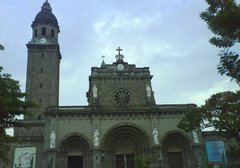
A Tale Of The Santo Nino
It is told that when, in the days of Legaspi, the capital was moved from Cebu to Manila, the authorities decreed that the image of the Sto. Nino should also be moved to the new capital.
So, the image was crated and shipped to manila, but the crate arrived there empty. The image miraculously disappeared, reappearing in its shrine in Cebu. It was recreated, and the crate placed inside another box, and then shipped to manila. Again, the boxes arrived in Manila empty. The image was crated a third time, and the crate placed not in one but in two boxes - but in vain. The Santo Nino was back in Cebu.
Eventually, the shippers sent the image out in a series of Chinese boxes, one inside another, with the seventh and inner-most box containing the image. In this manner, the image arrived in Manila and was enthroned in the Augustinian church of the capital city. The image, however, kept disappearing from the Augustinian church and reappearing in its shrine in Cebu. And so, it is told, the Manila Augustinians decided to cut off one of the Holy Child’s legs to stop it from escaping and returning to Cebu. This proved of no avail. The Santo Nino still kept on returning to Cebu
Manila finally gave up and Cebu kept its little Lord. Today, it is said, one can still notice how unevenly the Santo Nino stands. It is a sign of how, at one time, it had been amputated to keep it from returning to its beloved home.
In other versions of this story, the image was shipped not to Manila but to Spain. Whatever the version, however, it is a story told to show how intimately wedded to each other Cebu and the Santo Nino have become.
IMAGE OF SANTO NIÑO - Considered as the oldest religious relic in the Philippines. It was on April 14, 1521 that Magellan gave the image to Queen Juana as a baptismal gift. Forty-four years later, on April 27,1565 when Miguel Lopez de Legaspi arrived, Fr. Andres de Urdaneta who formally Christianized the Cebuanos, found the Native hostile. Legaspi besieged the settlement and set the village on fire. It was on one of the burnt houses that Juan Camus, a soldier, found the image of Sto. Niño unscratched. Since then, the miraculous image has been venerated by the Cebuanos as its patron saint. At present, the miraculous image is kept in the parish convent, and a replica is adorned with gold and precious stones and enshrined in glass. It is housed in a side altar inside the Basilica Minor del Santo Niño.




No comments:
Post a Comment